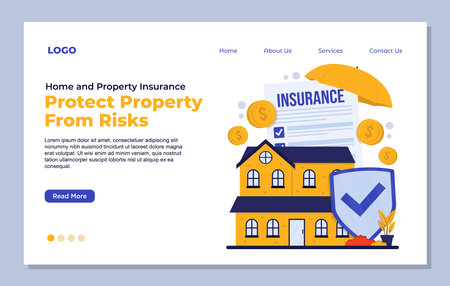Understanding Flood Insurance
Flood insurance is a specific type of coverage designed to protect your home and personal property from losses caused by flooding. Many homeowners and renters in the United States mistakenly believe that their standard insurance policies automatically cover flood damage, but that’s not the case. Understanding the basics of flood insurance is essential for anyone who wants to make sure their property and belongings are truly protected.
What Is Flood Insurance?
Flood insurance helps cover the costs of repairing or replacing your home and possessions if they’re damaged by flooding. A flood is typically defined as an overflow of water onto normally dry land, which can be caused by heavy rain, hurricanes, melting snow, or even blocked storm drains.
How Does Flood Insurance Differ from Standard Homeowners and Renters Insurance?
| Coverage Type | Standard Homeowners/Renters Insurance | Flood Insurance |
|---|---|---|
| Fire Damage | Covered | Not Covered |
| Theft & Vandalism | Covered | Not Covered |
| Wind Damage (non-flood) | Covered | Not Covered |
| Flood Damage (natural disasters, storms, heavy rain) | Not Covered | Covered |
| Mold Due to Flooding | Not Covered (unless caused by covered peril) | May Be Covered (if due to flood) |
| Sewer Backup (not caused by flooding) | Sometimes Covered (with endorsement) | Not Covered |
| Sewer Backup (caused by flooding) | Not Covered | Not Covered (needs separate policy/endorsement) |
Why Is Flood Insurance Essential?
- Most Homeowners Policies Don’t Cover Floods: If you only have a regular homeowners or renters policy, you’re likely not protected against flood losses.
- The Risk Is Widespread: According to FEMA, just one inch of floodwater in your home can cause thousands of dollars in damage, and floods can happen anywhere—it’s not just high-risk areas that are vulnerable.
- Lenders May Require It: If you live in a high-risk area and have a mortgage backed by the federal government, you may be required to carry flood insurance.
- Pays for Repair and Replacement: Flood insurance helps cover the cost of repairing your home’s structure and replacing damaged belongings after a flood event.
- No Federal Disaster Guarantee: Federal disaster assistance is only available if the president declares a disaster—and it usually comes as a loan you’ll need to repay. With flood insurance, you’re protected regardless of whether there’s an official disaster declaration.
A Quick Comparison: Who Needs Flood Insurance?
| If You Are… | Your Need for Flood Insurance |
|---|---|
| A homeowner in a high-risk zone with a mortgage | Lender will require it |
| A homeowner in a moderate- or low-risk zone | Lender may not require it, but coverage is still recommended |
| A renter | You can get coverage for your belongings (but not the building itself) |
| An owner of a condo or townhouse | You may need both building and contents coverage depending on association policy |
If you want peace of mind and full protection for your property, understanding what flood insurance offers—and how it differs from your other policies—is the first step toward being prepared for whatever Mother Nature brings.
2. Who Needs Flood Insurance?
Understanding When Flood Insurance Is Essential
Flood insurance isn’t just for people living near rivers or the coast—many Americans underestimate their risk. According to FEMA, more than 20% of flood claims come from properties outside high-risk flood zones. Floods can happen anywhere it rains, and standard homeowners or renters insurance policies usually don’t cover flood damage.
Flood Zones: What Do They Mean?
Your need for flood insurance often depends on your propertys location within a designated flood zone. The Federal Emergency Management Agency (FEMA) maps these zones to show areas with different levels of flood risk.
| Flood Zone | Risk Level | Insurance Requirement |
|---|---|---|
| Zone A/AE/AH/AO | High Risk | Required by lenders if you have a mortgage |
| Zone X (shaded) | Moderate Risk | Recommended but not required |
| Zone X (unshaded) | Low Risk | Optional, but wise to consider |
Mortgage Requirements: When You Don’t Have a Choice
If you have a federally backed mortgage and your home is in a high-risk flood zone, your lender will require you to buy flood insurance. Even if you don’t live in a high-risk area, some lenders may still encourage it for extra protection. Renters with valuable possessions in basement apartments or ground-floor units should also consider coverage—even if it’s not required.
Common Misconceptions About Flood Risk
- “I’m not in a high-risk zone, so I don’t need it.” – Floods can and do happen outside high-risk zones. Just a few inches of water can cause thousands of dollars in damage.
- “Disaster assistance will cover me.” – Federal aid is only available after a presidential disaster declaration—and most forms are loans that must be repaid.
- “My home insurance covers floods.” – Standard homeowners and renters policies almost never include flood coverage. You need a separate policy for flood protection.
Scenarios Where Flood Insurance Makes Sense
- You live in an area prone to heavy rain or hurricanes.
- Your property is near lakes, rivers, or streams—even if it’s not officially in a high-risk zone.
- You own a basement apartment or store valuables on the ground floor.
- Your community has experienced flooding in the past, even if it’s rare.
![]()
3. What Does Flood Insurance Cover?
If you’re thinking about getting flood insurance, it’s important to know exactly what’s protected—and what’s not. Whether you own your home or rent, understanding the difference between building coverage and personal property coverage can help you make the best decision for your situation.
Building Coverage vs. Personal Property Coverage
Flood insurance generally splits protection into two main categories: one for the structure of the building itself, and one for the stuff inside. Here’s a simple breakdown:
| Building Coverage | Personal Property Coverage | |
|---|---|---|
| What’s Covered? | – Foundation, walls, floors – Electrical and plumbing systems – Central air conditioning, furnaces, water heaters – Built-in appliances like dishwashers – Permanently installed carpeting (over unfinished floors) – Detached garages (limited) |
– Clothing – Furniture – Electronics – Curtains – Portable appliances (microwaves, window AC units) – Rugs and carpets not permanently installed – Washer and dryer |
| Who Needs It? | Homeowners (required by many lenders in high-risk flood zones) | Homeowners & Renters (renters can insure their belongings even if they don’t own the building) |
Common Exclusions: What’s Not Covered?
It’s just as important to know what most standard flood insurance policies don’t cover. Here are some common exclusions:
- Damage caused by moisture, mildew, or mold that could have been avoided by the homeowner
- Living expenses if you need to relocate temporarily (like hotel stays or meals)
- Cars and other vehicles (these may be covered under auto insurance with comprehensive coverage)
- Money, precious metals, and valuable papers (like stock certificates)
- Outdoor property such as patios, decks, landscaping, pools, fences, and hot tubs
- Basement improvements like finished walls or floors and personal belongings stored in basements (coverage is limited)
A Quick Tip for Homeowners and Renters
If you rent your place, remember that your landlord’s policy likely only covers the building—not your stuff inside! Make sure you consider a separate contents policy to protect your belongings from flood damage.
4. How to Get Flood Insurance
If you’re considering flood insurance, it’s important to know your options and how the process works in the United States. Here’s a step-by-step guide to help homeowners and renters get started.
Understand Your Flood Risk
The first step is to find out if your property is in a flood zone. You can check flood maps on the FEMA website or ask your local government office. Even if you’re not in a high-risk area, about 1 in 4 flood claims come from low- or moderate-risk zones.
Know Where to Buy Flood Insurance
Flood insurance in the U.S. is mainly available through two sources: the National Flood Insurance Program (NFIP) and private insurers.
| Source | Who Can Buy | How to Buy | Coverage Details |
|---|---|---|---|
| National Flood Insurance Program (NFIP) | Homeowners & Renters in participating communities | Through most insurance agents or companies (Ask if they sell NFIP policies) |
Covers building & contents separately Standard coverage limits apply |
| Private Insurers | Anyone, but availability varies by state & risk level | Contact private insurance companies directly | May offer higher limits or extra options Terms and pricing can differ from NFIP |
Steps to Purchase Flood Insurance
- Contact Your Insurance Agent: Ask if they offer NFIP policies or private flood insurance. If you don’t have an agent, you can find one through FEMA’s FloodSmart.gov provider tool.
- Get a Quote: Provide information about your home or rental property—address, type of construction, and elevation (if available).
- Review Coverage Options: Decide whether you need building coverage, contents coverage, or both. Renters can buy contents-only policies.
- Submit an Application: Complete the application with your agent. You may need supporting documents like proof of ownership or lease agreement.
- Pay the Premium: Most policies require payment upfront. For NFIP policies, there’s typically a 30-day waiting period before coverage starts (unless required for a new mortgage).
- Keep Records: Save your policy documents and receipts in a safe place for easy access if you ever need to file a claim.
A Few Helpful Tips
- If you live in a high-risk flood area and have a federally backed mortgage, you may be required to carry flood insurance.
- You don’t need to live near water to experience flooding—heavy rain, storms, or snowmelt can all cause floods.
- You can purchase flood insurance at any time, but remember the waiting period before it takes effect.
- Your standard homeowners or renters policy does not cover flood damage—you must purchase separate coverage.
5. Tips for Filing a Flood Insurance Claim
Understanding the Claims Process
If your home or rental property is hit by a flood, knowing how to file a flood insurance claim can help you get back on your feet faster. The process may feel overwhelming, but breaking it down into steps can make things much easier.
Step-by-Step Guide to Filing a Flood Insurance Claim
| Step | What to Do |
|---|---|
| 1. Contact Your Insurer ASAP | Call your flood insurance company or agent as soon as possible after the flood. Have your policy number ready. |
| 2. Document the Damage | Take photos and videos of all affected areas and items before cleaning or making repairs. |
| 3. Make a Detailed List | Write down everything that was damaged or lost, including descriptions, approximate values, and purchase dates if possible. |
| 4. Prevent Further Damage | If safe, take reasonable steps to prevent more damage (like covering broken windows). Save receipts for any emergency repairs. |
| 5. Meet with the Adjuster | Your insurer will send an adjuster to inspect your property. Be present to answer questions and provide your documentation. |
| 6. Submit Your Proof of Loss | Complete and sign the “Proof of Loss” form, attaching all necessary documentation. This is usually required within 60 days of the flood. |
Essential Documentation You’ll Need
- Photos/Videos: Clear images showing all damage to your property and belongings.
- Inventory List: A detailed list of damaged personal property with descriptions and estimated values.
- Receipts & Records: Any receipts for big-ticket items, repairs, or temporary housing costs.
- Your Policy Info: Keep your flood insurance policy number handy at all times during this process.
- Communication Log: Notes on every conversation you have with your insurer or adjuster, including names, dates, and details discussed.
Navigating Potential Challenges After a Flood Event
Troubleshooting Common Issues
- If You Disagree With the Adjuster: Let your insurance company know in writing if you think the damage estimate is too low. You can request a second inspection or provide additional evidence like contractor estimates.
- If You Missed Something: If you discover new damage after filing, contact your insurer right away—there may be time limits for adding claims.
- If Payment Is Delayed: Stay in regular contact with your insurer. Ask about the status of your claim and what’s needed to move things forward.
- If You Need Help: Consider reaching out to FEMA’s disaster assistance programs or local recovery resources if you face significant setbacks during the claims process.
Helpful Tip:
The sooner you start the claims process and gather documentation, the smoother things will go. Don’t throw anything away until after the adjuster has seen it—even if it’s ruined!


